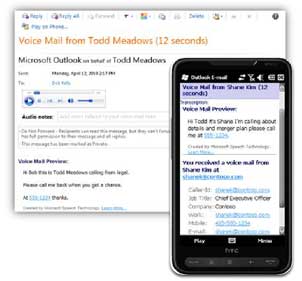
Voicemail with Exchange Unified Messaging (EUM) you get:
- Voicemails, missed calls and e-mail messages consolidated into your Outlook inbox and mobile device
- Ability to read your voicemail messages with the automatic speech to text feature
- Ability to customize caller greetings and call transfer options
- Ability to reset your own voicemail passcode
This technology will allow you to improve and accelerate business communications and customer service to its fullest extent.
Frequently Asked Questions
Q: What is Exchange Unified Messaging (EUM)?
A: It is the new term for our advanced voicemail technology that utilizes the Exchange e-mail system to record and deliver voicemail messages.
Q: Why are we changing to EUM from the previous voicemail system?
A: The previous voicemail system is well past the end of its service life and must be replaced. Exchange EUM integrates well with our existing systems, provides a number of new features, and is cost-effective.
Q: When will this service begin?
A: All voicemail customers (except those with telephone numbers starting with “450”) should now be on the new system. Customers with "450" numbers will be migrated to the new system at a later date. Otherwise, if you are still receiving voicemail messages on the old system (7-7703), please contact the IMS Service Desk.
Q: Do I need to do anything different to check my messages?
A: Simply listen to and/or read the message from your e-mail inbox. However, if you wish, you can still call into the voicemail system and retrieve messages like you always have, although you’ll now use a different access number. See the instructions under “Access Voice Mail” here
Q: Do voicemail messages count against my mailbox quota?
A: Yes. If your mailbox goes over quota, you will not be able to receive new voice mail messages and callers will be told that your mailbox is full. Fortunately, most voice mail messages are relatively small (< 50 KB), but we recommend that you make it a habit to delete or archive messages (both e-mail and voice mail) that are no longer pertinent so as to keep your mailbox size down.
Q: Why is the voicemail “preview” (transcription) inaccurate?
A: The voicemail preview is not intended to replace the actual recorded message, but rather is intended to be “good enough” to give you the gist of the message so you can quickly triage it. This can be especially helpful when you’re trying to sort through a large number of messages or if you’re viewing the message on a mobile device and need to determine whether to step away from a meeting to listen to the message and/or return the call. The preview will be less accurate when there is background noise, if there is specialized vocabulary, or if the speaker is speaking softly or has an accent. Messages longer than 90 seconds are not transcribed. If you like, you can disable the preview for all messages you receive in the voice mail settings in OWA.
Q: Why does the Caller ID on a voicemail message show incorrect information?
A: There is a predetermined resolution sequence to match an incoming phone number with a name. Exchange will first check various entries in the Exchange Global Address List (GAL) for a match. If none is found, it will then check your personal contacts. If incorrect information is being shown, it is because there is incorrect data in one of those places. Please contact the IMS Service Desk for assistance in troubleshooting and resolving these issues.
Q: Where can I get more information?
A: Call the UTHSCSA Service Desk at 567-7777, email at IMS Service Desk or drop by MED 411L